三年级英语下册 第一单元 精讲笔记
- 格式:pptx
- 大小:68.45 KB
- 文档页数:16

三年级下册英语第一单元知识点整理本页仅作为文档页封面,使用时可以删除This document is for reference only-rar21year.March三年级下册英语第一单元知识点整理1.核心单词open 开,打开 the 这个;这些;那个;那些door 门 close 关上;合上window 窗,窗户 book 书blackboard 黑板 don’t=do not 不要2.必备短语in class 在上课 stand up 起立sit down 坐下 open the book 把书打开close the book 把书合上 look at... 看... listen to... 听... come in 进来3.必备句型(1)Good morning, class. 早上好,同学们。
(2)Please open the door. 请把门打开。
(3)I’m sorry, Mr Green. 对不起,格林先生。
(4)Come in, Mike. 进来,Mike。
(5)Look at the blackboard, Sam. 看黑板,Sam。
(6)--What’s this --It’s a robot. --这是什么-(7)-这是一个机器人。
(8)Don’t listen to the parrot, Sam! 不要听鹦鹉的话,Sam。
4.实用句型(1)Bob has two big, big books. Bob有两本大大的书。
(2)Open your book and say “Hello!” 把你的书打开,说“你好!”(3)Close your book and off we go! 把你的书合上,我们走吧!5.核心语法Please open/close...是简单的祈使句。
想要请别人干某事的时候,运用时可以加”please”表示礼貌。
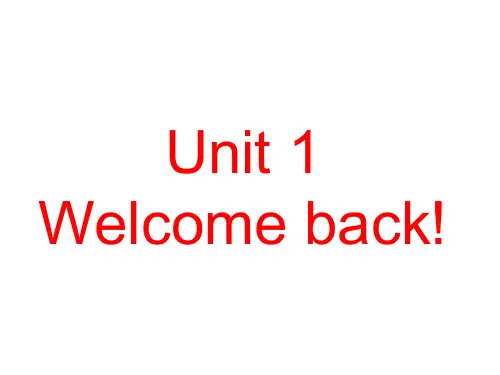
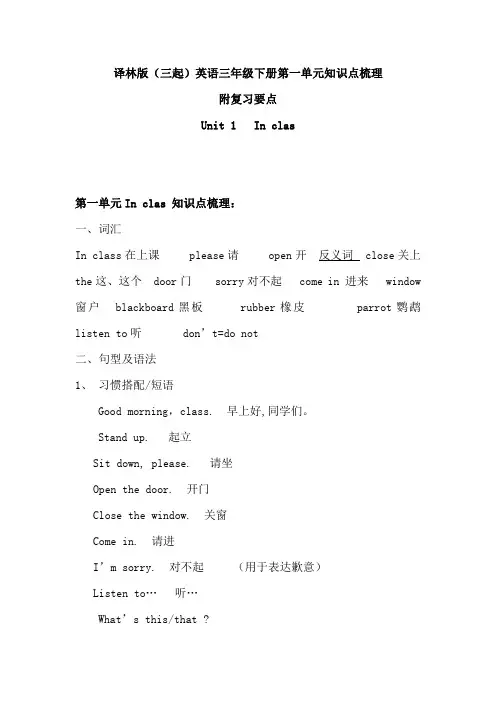
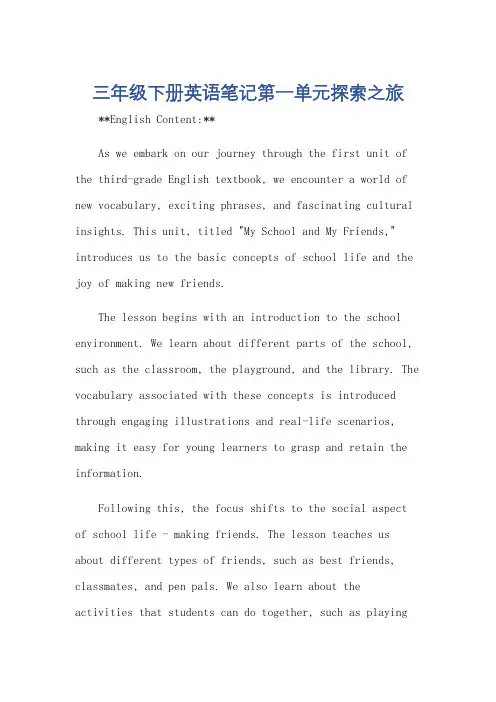
三年级下册英语笔记第一单元探索之旅**English Content:**As we embark on our journey through the first unit of the third-grade English textbook, we encounter a world of new vocabulary, exciting phrases, and fascinating cultural insights. This unit, titled "My School and My Friends," introduces us to the basic concepts of school life and the joy of making new friends.The lesson begins with an introduction to the school environment. We learn about different parts of the school, such as the classroom, the playground, and the library. The vocabulary associated with these concepts is introduced through engaging illustrations and real-life scenarios, making it easy for young learners to grasp and retain the information.Following this, the focus shifts to the social aspect of school life - making friends. The lesson teaches us about different types of friends, such as best friends, classmates, and pen pals. We also learn about theactivities that students can do together, such as playingsports, doing homework, and sharing stories. The lesson encourages students to appreciate the diversity of their classmates and to value the friendships they form.Throughout the unit, there are various interactive exercises that help students practice their newly acquired vocabulary and phrases. These exercises range from simple matching games to role-playing scenarios that require students to use their imagination and creativity.Additionally, the unit includes cultural notes that introduce students to different customs and traditions from around the world. This helps to broaden their horizons and understand that school life and making friends are universal experiences that are shared by children everywhere.By the end of this unit, students not only have a solid grasp of the vocabulary and phrases related to school life and friendships, but they also have a deeper understanding of the value of education and the importance of making meaningful connections with others.**中文内容:**随着我们踏上三年级英语课本第一单元的旅程,我们遇到了一个充满新词汇、激动人心的短语和迷人文化洞察力的世界。
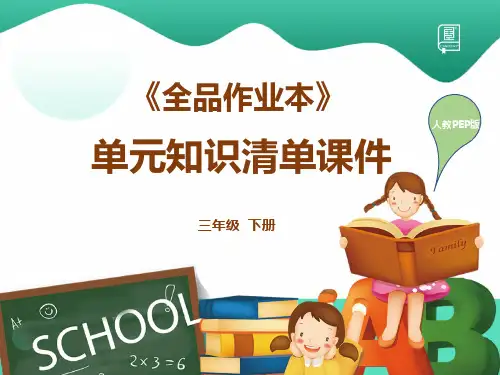
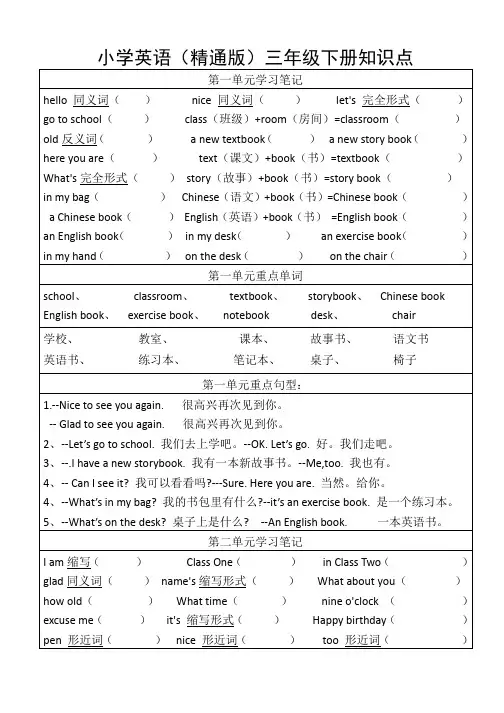
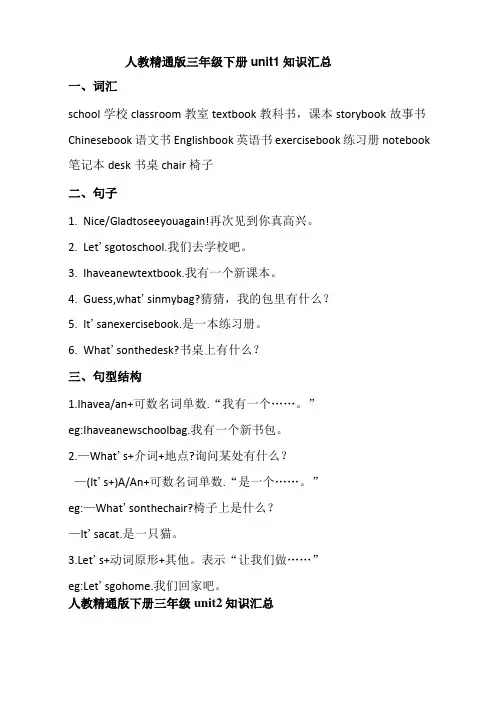
人教精通版三年级下册unit1知识汇总一、词汇school学校classroom教室textbook教科书,课本storybook故事书Chinesebook语文书Englishbook英语书exercisebook练习册notebook 笔记本desk书桌chair椅子二、句子1.Nice/Gladtoseeyouagain!再次见到你真高兴。
2.Let'sgotoschool.我们去学校吧。
3.Ihaveanewtextbook.我有一个新课本。
4.Guess,what'sinmybag?猜猜,我的包里有什么?5.It'sanexercisebook.是一本练习册。
6.What'sonthedesk?书桌上有什么?三、句型结构1.Ihavea/an+可数名词单数.“我有一个……。
”eg:Ihaveanewschoolbag.我有一个新书包。
2.—What's+介词+地点?询问某处有什么?—(It's+)A/An+可数名词单数.“是一个……。
”eg:—What'sonthechair?椅子上是什么?—It'sacat.是一只猫。
3.Let's+动词原形+其他。
表示“让我们做……”eg:Let'sgohome.我们回家吧。
人教精通版下册三年级unit2知识汇总eg : 一、词汇one 一two 二three 三four 四five 五six 六seven 七eight 八nine 九ten 十eleven 十一twelve 十二二、句子1. I'mMike.What'syourname?我是迈克。
你叫什么名字?2. Myname'sAnn.我叫安。
3. I'minClassFour,GradeThree.我在三年级四班。
4. Whataboutyou?你怎么样?5. Howoldareyou?你几岁了?6. I'meight.我八岁了。
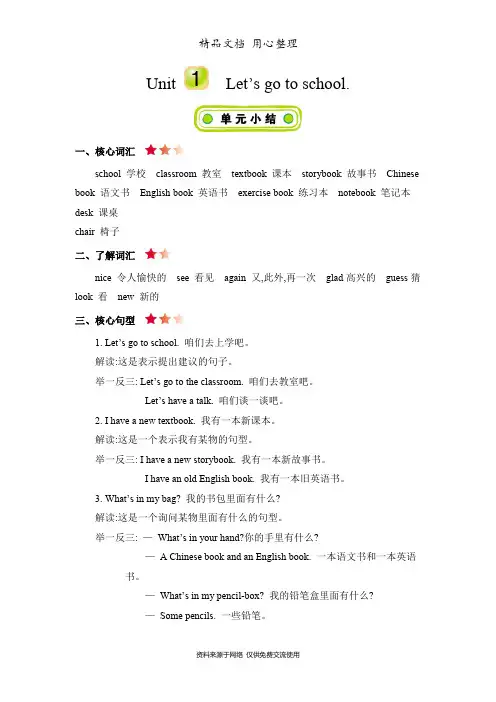
Unit Let’s go to school.一、核心词汇school 学校classroom 教室textbook 课本storybook 故事书Chinese book 语文书English book 英语书exercise book 练习本notebook 笔记本desk 课桌chair 椅子二、了解词汇nice 令人愉快的see 看见again 又,此外,再一次glad高兴的guess猜look 看new 新的三、核心句型1. Let’s go to school. 咱们去上学吧。
解读:这是表示提出建议的句子。
举一反三: Let’s go to the classroom. 咱们去教室吧。
Let’s have a talk. 咱们谈一谈吧。
2. I have a new textbook. 我有一本新课本。
解读:这是一个表示我有某物的句型。
举一反三: I have a new storybook. 我有一本新故事书。
I have an old English book. 我有一本旧英语书。
3. What’s in my bag? 我的书包里面有什么?解读:这是一个询问某物里面有什么的句型。
举一反三: —What’s in your hand?你的手里有什么?— A Chinese book and an English book. 一本语文书和一本英语书。
—What’s in my pencil-box? 我的铅笔盒里面有什么?—Some pencils. 一些铅笔。
4. What’s on the chair? 椅子上面有什么?解读:这是一个询问某物上面有什么的句型。
举一反三: What’s on the bed?床上面有什么?What’s on my desk?我的课桌上面有什么?四、了解句型1. Nice to see you again. 很高兴再次见到你。
解读:这是一个常见的打招呼用语。
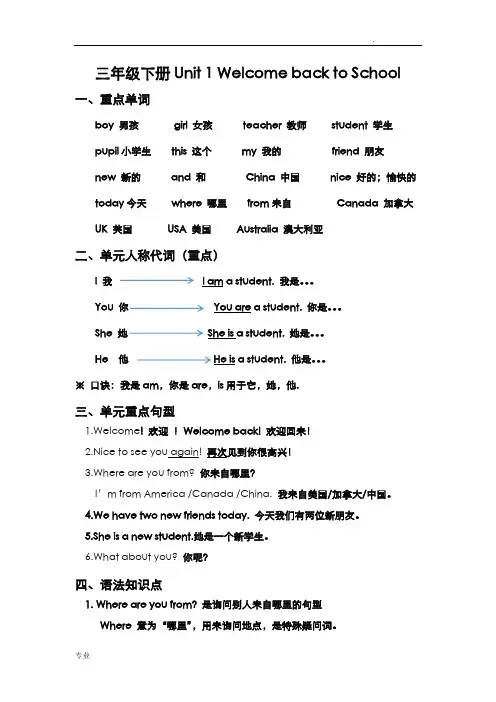
三年级下册Unit 1 Welcome back to School 一、重点单词boy 男孩girl 女孩teacher 教师student 学生pupil小学生this 这个my 我的friend 朋友new 新的and 和China 中国nice 好的;愉快的today今天where 哪里from来自Canada 加拿大UK 英国USA 美国Australia 澳大利亚二、单元人称代词(重点)I 我I am a student. 我是。
You 你You are a student. 你是。
She 她She is a student. 她是。
He 他He is a student. 他是。
※口诀:我是am,你是are,is用于它,她,他.三、单元重点句型1.Welcome! 欢迎!Welcome back! 欢迎回来!2.Nice to see you again! 再次见到你很高兴!3.Where are you from? 你来自哪里?I’m from America /Canada /China.我来自美国/加拿大/中国。
4.We have two new friends today. 今天我们有两位新朋友。
5.She is a new student.她是一个新学生。
6.What about you? 你呢?四、语法知识点1.Where are you from?是询问别人来自哪里的句型Where 意为“哪里”,用来询问地点,是特殊疑问词。
From “来自”的意思例如:Where is she from?她来自哪里?Where are you from?你来自哪里?2.I’m from.....是介绍自己来自哪里的句型。
I’m from +国家/城市/地名例如:I’m from Jiangxi.3.have 的用法(1)have可以表示“吃,喝”例如:Have some bread. 吃些面包吧。
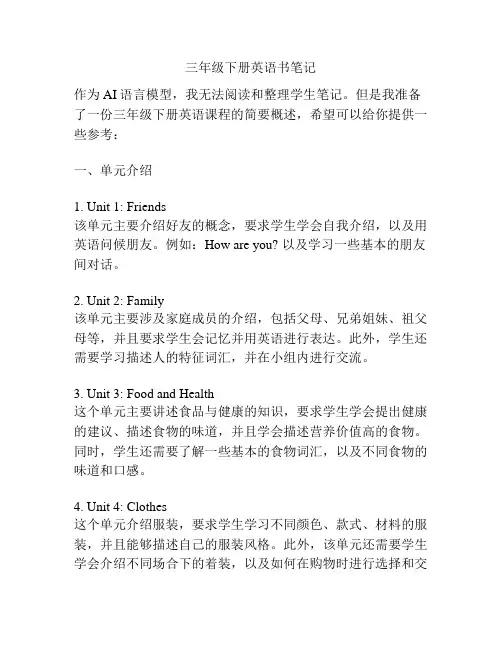
三年级下册英语书笔记作为AI语言模型,我无法阅读和整理学生笔记。
但是我准备了一份三年级下册英语课程的简要概述,希望可以给你提供一些参考:一、单元介绍1. Unit 1: Friends该单元主要介绍好友的概念,要求学生学会自我介绍,以及用英语问候朋友。
例如:How are you? 以及学习一些基本的朋友间对话。
2. Unit 2: Family该单元主要涉及家庭成员的介绍,包括父母、兄弟姐妹、祖父母等,并且要求学生会记忆并用英语进行表达。
此外,学生还需要学习描述人的特征词汇,并在小组内进行交流。
3. Unit 3: Food and Health这个单元主要讲述食品与健康的知识,要求学生学会提出健康的建议、描述食物的味道,并且学会描述营养价值高的食物。
同时,学生还需要了解一些基本的食物词汇,以及不同食物的味道和口感。
4. Unit 4: Clothes这个单元介绍服装,要求学生学习不同颜色、款式、材料的服装,并且能够描述自己的服装风格。
此外,该单元还需要学生学会介绍不同场合下的着装,以及如何在购物时进行选择和交流。
5. Unit 5: School life该单元主要介绍学校生活,在学生熟悉的学校场景中,学习如何介绍学校设施,掌握简单的日常用语和表达方式。
同时,学生还将从听说读写四个方面练习,巩固英文水平。
6. Unit 6: Animals该单元主要涉及动物的知识,要求学生学习不同的动物名称、特征、栖息地等方面的知识,并练习用英语进行交流。
此外,在该单元中,学生还需要能够描述动物的形状、大小等特点,从而进行更为深入的交流。
7. Unit 7: Festivals该单元主要介绍一些重要的节日,要求学生学会用英语进行问候、祝福,并且了解节日的来历、习俗等方面的知识。
同时,学生还需要学习基本的节日口语表达方式,并通过小组内交流提高自己的英文水平。
8. Unit 8: Travel该单元主要讲述旅游相关知识,包括旅游景点、交通方式等方面的内容,并且要求学生能够用英语进行信息查询、问路等操作。
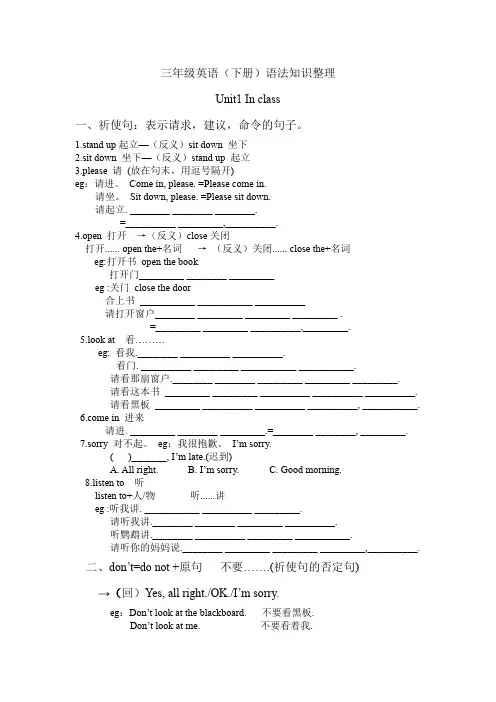
三年级英语(下册)语法知识整理Unit1 In class一、祈使句:表示请求,建议,命令的句子。
1.stand up起立—(反义)sit down 坐下2.sit down 坐下—(反义)stand up 起立3.please 请(放在句末,用逗号隔开)eg:请进。
Come in, please. =Please come in.请坐。
Sit down, please. =Please sit down.请起立. ________ ________ ________.=__________ _________,__________.4.open 打开→(反义)close关闭打开...... open the+名词→(反义)关闭...... close the+名词eg:打开书open the book打开门_________ ________ _________eg :关门close the door合上书___________ ___________ __________请打开窗户________ _________ _________ _________ .=_________ _________ __________,_________.5.look at 看………eg: 看我.________ __________ __________.看门. __________ _________ ___________ ___________.请看那扇窗户.________ ________ _________ _________ _________.请看这本书_________ _________ __________ __________ __________.请看黑板_________ __________ __________ __________, ___________.e in 进来请进. _________ ________ _________.=________ ________, _________. 7.sorry 对不起。
PEP英语三年级下册Unit 1 知识梳理【单元语音归纳】字母发音发音要领口型例词a /æ//æ/是短元音,是字母a在重读闭音节中的发音。
发音时舌尖抵下齿;舌前部稍抬高,舌位比/e/更低;双唇平伸,成扁平形。
cat, bag, dad, hand【重点词语盘点】1. UK英国2. Canada加拿大3. USA美国4. China中国5. she她6. student学生7. pupil学生;(尤指)小学生8. he他9. teacher教师10. be from来自【重点句型再现】1. Welcome! 欢迎!——句型结构:Welcome!2.-Where are you from? 你是哪里人?-I’m __________ t he UK. 我是英国人。
——句型结构:—Where are you from? 你是哪里人?—I’m from… 我是……人。
用于询问对方的国籍或籍贯并回答。
3. We have two new friends today. 今天我们有两位新朋友。
——句型结构:“We have+人物/事物.”表达“我们拥有……”。
4. She is a student.她是一名学生。
He is a teacher. 他是一位教师。
——句型结构:He/She is…用于介绍某人身份或其它情况。
【核心知识速记】速记单词(一)世界这么大,我想去看看。
我的祖国叫China ,枫叶之国是C anada。
自由女神在USA,大本钟在UK。
(二)分清男女靠s,把它想成小辫子。
he, he是男他,she, she是女她。
student, pupil是学生,勤奋刻苦爱学习。
teacher教师了不起,教授知识和道理。
速记句式1. welcome的用法单纯的表示“欢迎”或用在标语、口号中,只需要简单地使用“Welcome!”Welcome! 欢迎!若要具体表达欢迎来到某地,Welcome可以和to搭配使用Welcome to China. 欢迎来中国。
三年级下册Unit1In class知识点一、要点梳理词汇door门,book书,rubber橡皮,window窗户,blackboard黑板,parrot 鹦鹉,in class在上课,open打开,close关上,sit down坐下,stand up 起立,please请,sorry对不起,come in进来,listen to听,Mr先生, the这个;这些;那个;那些,this这个句型1.---Stand up.起立。
---Good morning,class.早上好,同学们。
---Good morning,Mr Green.早上好,格林老师。
---Sit down,please.请坐。
2.---Liu Tao,please open the door.刘涛,请把门打开。
---Yes,Mr Green.好的,格林老师。
3.---Wang Bing,please close the window.王兵,请把窗户关上。
---Yes,Mr Green.好的,格林老师。
4.---I’m sorry,Mr Green.对不起,格林老师。
---Come in,Mike.进来,迈克。
5.Look at the blackboard.看黑板。
6.---What’s this?这是什么?---It’s a rubber.它是一块橡皮。
二、词汇1.door门常用短语:open the door开门close the door关门2.book书常用短语:English book英语书open the book打开书3.rubber橡皮近义词:eraser4.window窗户常用短语:open the window开窗close the window关窗5.blackboard黑板常见短语:look at the blackboard看黑板on the blackboard在黑板上6.parrot鹦鹉常见短语:a nice parrot一只漂亮的鹦鹉7.in class在上课8.open打开反义词:close关上9.close关上反义词:open打开10.sit down坐下11.stand up起立解析:stand up和sit down是一对反义词组。
Unit1 知识详解A Let’s talk 知识详解重难点1.如何介绍自己来自哪里—I’m from ...课文应用:I’m from the UK. 我来自英国。
句型结构:I’m from + 地点.重点解析:此句型用于介绍自己来自哪里。
I’m是I am的缩写形式。
from后可接国名或地名。
此句型可用作“Where are you from?”的答语。
易错提示:这个句型中不要丢掉I后面的am,I am一般缩写为I’m。
生活实例:Mingming的班级来了一位外籍女教师,她是怎样向同学们介绍自己来自哪里的呢?让我们来看一看:Teacher: I’m Miss Green.I’m from the UK.我是格林老师。
我来自英国。
知识拓展:“来自……”的其他表达方式:come from也可以表示“来自……”。
例如:I come from China. 我来自中国。
2.热情的“welcome”课文应用:Welcome! 欢迎!welcome是个热情好客的小家伙,每当有朋友来到家里或学校时,它就会热情地欢迎。
有了它的帮助,我们就能表达欢迎了,快让我们和它交个朋友吧!如果你只是要对别人表示欢迎或用在标语、口号中,我们只需要简单地使用“Welcome!”就可以了。
例如:Welcome! Come in and meet my parents.欢迎!进来见见我的父母。
下面再教给大家几个简单的关于welcome的句子,大家都来表达自己的热情吧!例如:Welcome back (to school)! 欢迎回(到学校)来!Welcome to China! 欢迎来中国!A Let’s talk 知识详解拓展点1.如何表达“我们拥有……”—— We have ...课文应用:Boys and girls, we have two new friends today. 孩子们,今天我们有两位新朋友。
句型结构:We have + 名词(如: two friends, a new toy ...).重点解析:此句型用于表达“我们拥有……”,动词have意为“有;拥有”。
人教版三年级英语下册单元知识点及重点语法归纳复习资料Part1:三年级英语下册单元知识点Unit 1 Big or Small (大或小)【必背词汇】happy 快乐的tall 高的hot 热的big 大的sad悲伤的short短的cold冷的small小的hello 你好animal 动物good 好table 桌子they 他们or 或者and 和【重点句型】1.形容的状态(某人是…)用:人称代词+be动词+形容词.例句:Im big. 我是大的。
You’re big. 你是大的。
She’s small. 她是小的。
He’s small. 他是小的。
We’re happy. 我们是快乐的。
They’re cold. 他们是冷的。
2.不确定某人的状态(某人是…吗?)问:be动词+人+形容词?答:Yes, 人称代词+ is/are.No, 人称代词+is/ are not.例句:Are you happy ? - Yes, I am. / No, I am not.你是开心的吗? 是的,我是。
/ 不是的,我不是。
Are you sad? -Yes, we are. / No, we aren’t.你们是悲伤的吗?是的,我们是。
/ 不是的,我们不是。
Is she/ he tall? -Yes, she/he is. / No, she/ he isn’t.她/他是高的吗?是的她/他是。
/ 不是的,她/他不是。
Are they small? -Yes, they are. / No, they aren’t.他们是小的吗?是的,他们是。
/ 不是的,他们不是。
3.物体的状态也用同样的句形。
句型:单数/不可数名词+is +形容词。
例句:The table is small. It’s big.桌子是小的。
他是大的。
句型:复数+are +形容词。
例句:The apples are small. They’re big.苹果的是小的。
陕旅版三年级英语下册第一单元知识点整理Unit 1 My BodyIn this unit。
we will learn about different body parts and their names。
Here are some important words:Body: the physical structure of a person or animalHead: the upper part of the body that contains the brain。
eyes。
nose。
and mouthEye: the organ that we use to seeNose: the part of the face that we use to XXXXXX: XXX in the face that we use to eat and speakFace: the front part of the head that includes the eyes。
nose。
and mouthArm: the upper limb of the body that extends from the shoulder to the handEar: the organ that we use to hearHand: the part of the body that we use to hold and manipulate objectsLeg: the lower limb of the body that extends from the hip to the footFoot: the part of the body that we use to stand and walkWe also need to know some verbs that are related to the body。
最新部编版三年级英语下册第一单元知识点总结Unit 1: My Day在这个单元中,学生将研究与日常生活相关的话题。
以下是本单元的知识点总结:1. 日常活动学生将研究如何描述他们的日常活动。
以下是一些常见的日常活动词汇:- get up(起床)- have breakfast(吃早餐)- go to school(去学校)- have lunch(吃午饭)- do homework(做作业)- have dinner(吃晚饭)- go to bed(上床睡觉)2. 问答句型学生将研究如何用英语进行简单的问答。
以下是一些常用的问答句型:- What time do you...?(你什么时候...?)- I... at...(我在...的时候...)例句:- What time do you get up?(你几点起床?)- I get up at 7 o'clock.(我七点起床。
)3. 时间表达学生将学会表达时间。
以下是一些常用的时间表达方式:- o'clock(整点)- half past...(半点过...)- quarter past...(一刻过...)- quarter to...(离...还有一刻钟)例句:- It's 8 o'clock.(现在是八点。
)- It's half past nine.(现在是九点半。
)4. 课堂用语学生将研究一些常用的课堂用语。
以下是一些常见的课堂用语:- Open your book, please.(请打开书。
)- Close your book, please.(请合上书。
)- Listen carefully.(仔细听。
)- Repeat after me.(跟我重复。
)以上是最新部编版三年级英语下册第一单元的知识点总结。
通过研究这些内容,学生可以更好地描述他们的日常生活、询问和回答时间等方面的问题。
希望这个总结对您有所帮助!。